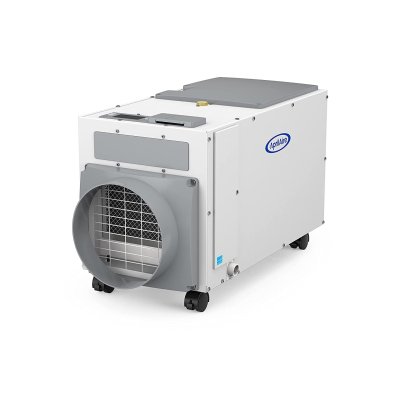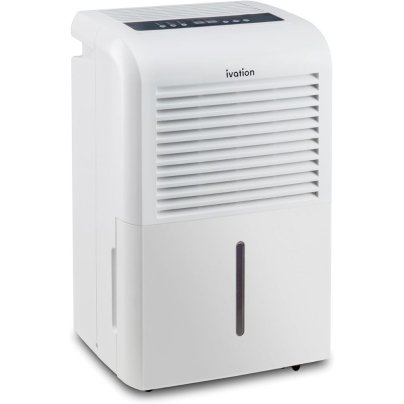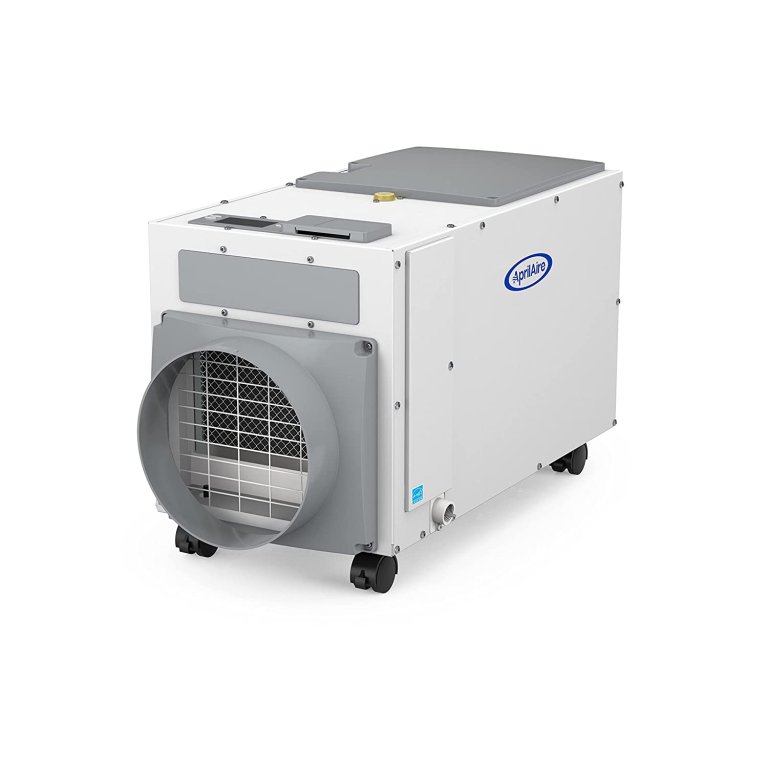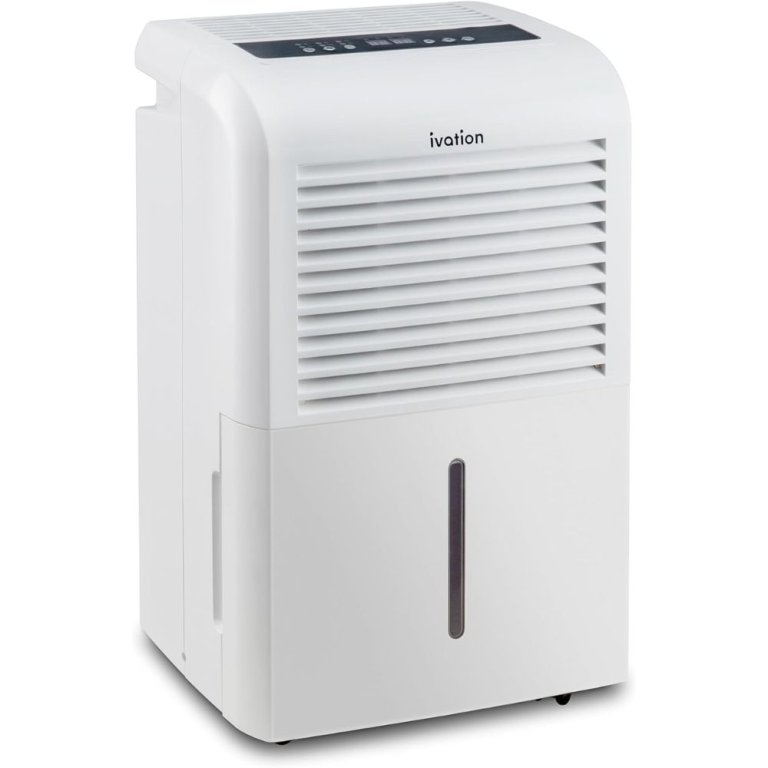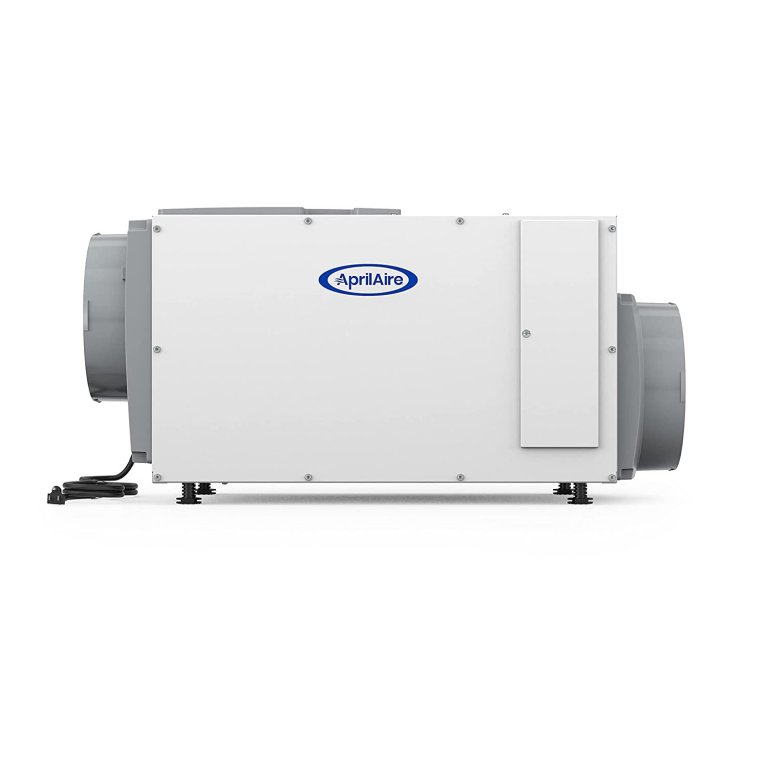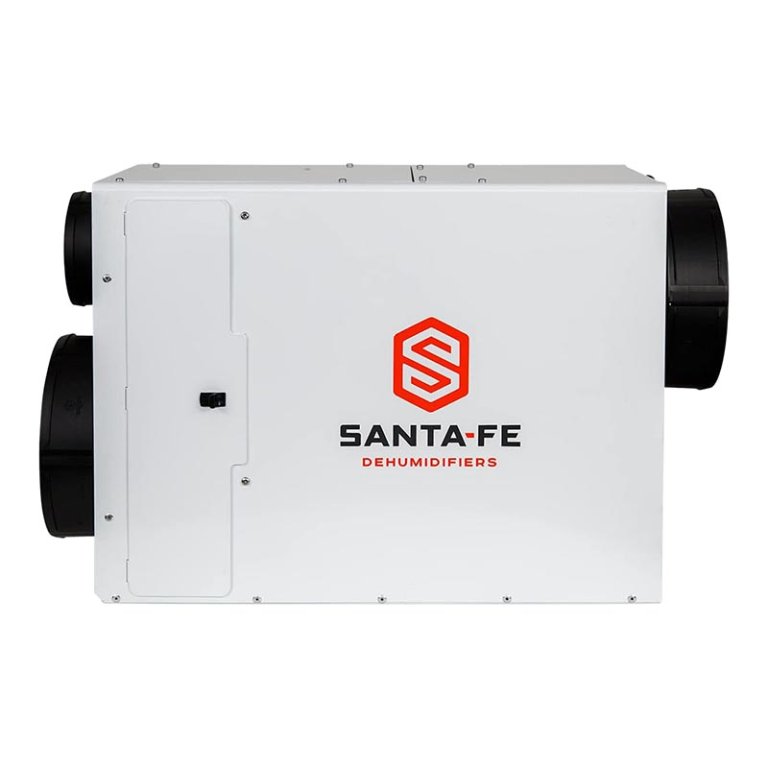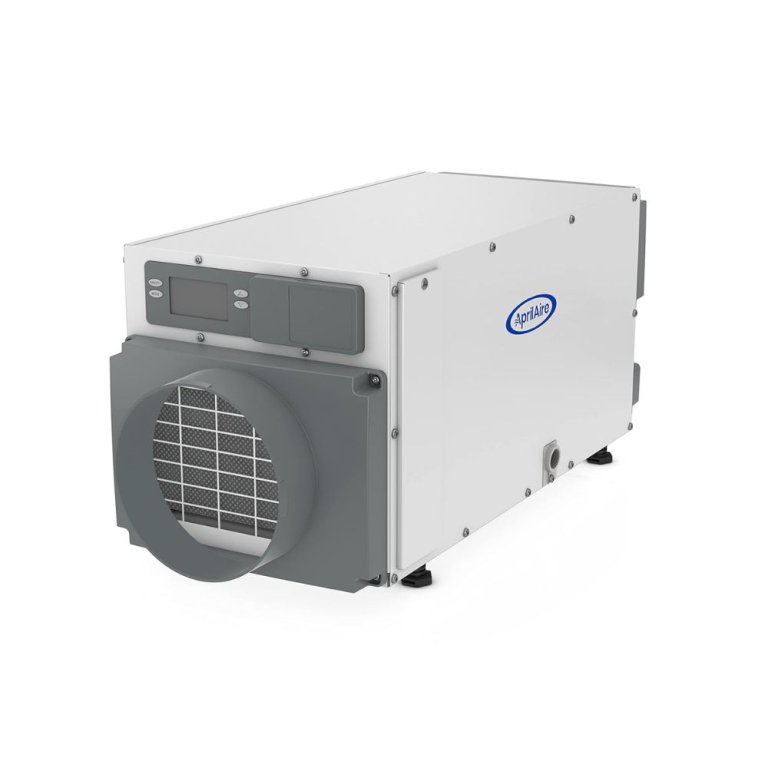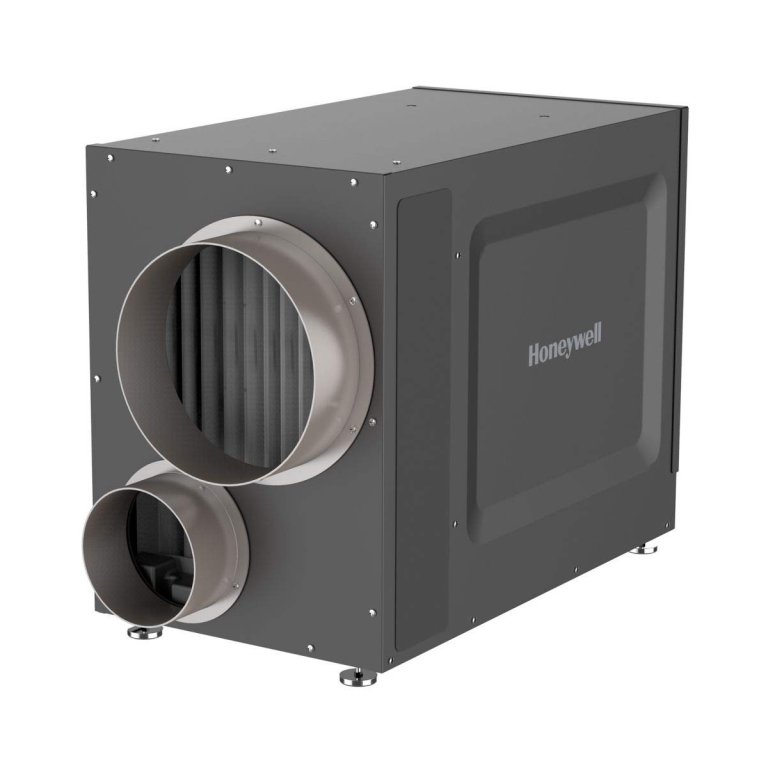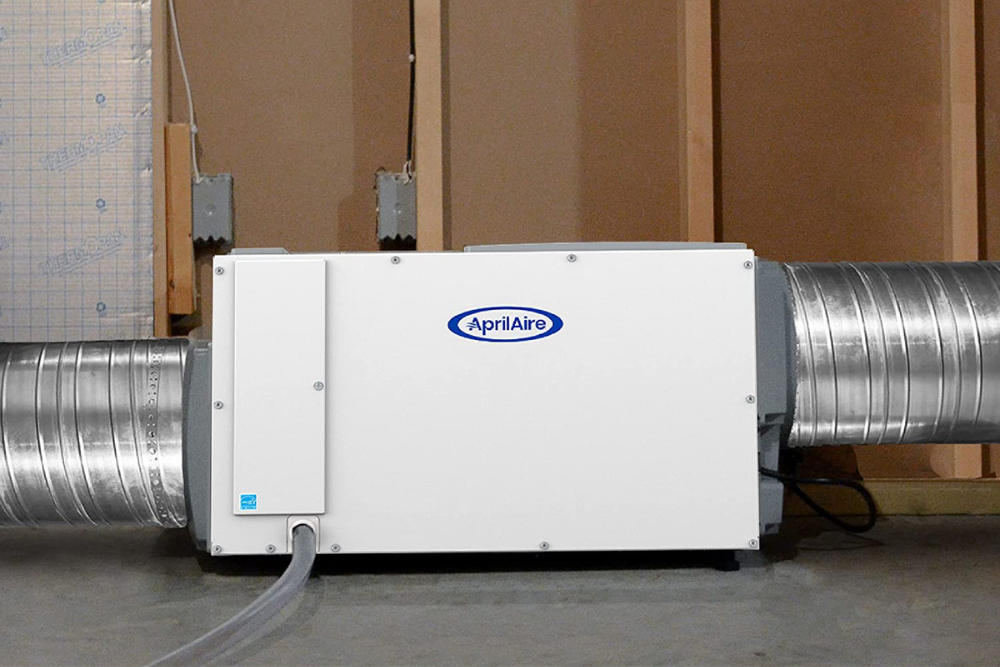
We may earn revenue from the products available on this page and participate in affiliate programs. Learn More ›
Whole-house dehumidifiers remove humidity from indoor air, reducing uncomfortable stickiness and mitigating the growth of mold that may trigger certain illness and cause interior damage to a home. If you live in a naturally humid region or are simply a fan of extra-long steamy showers, you may benefit from a whole-house dehumidifier.
The nice thing about whole-house dehumidifiers—also called “ducted” or “inline” dehumidifiers—is that they connect to the home’s HVAC system to remove moisture throughout every room in the house, not just one. They’re pricier than other types of dehumidifiers, and in many communities, local codes will require professional installation. But they’re usually pretty quiet and can help reduce cooling costs in warm weather seasons.
Our pick for best whole-house dehumidifier is the AprilAire E100C Pro 100-Pint Whole-House Dehumidifier, effective for spaces up to 5,500 square feet. It removes 100 pints of moisture daily and maintains humidity levels automatically, requiring little maintenance.
According to the U.S. Environmental Protection Agency, optimal indoor humidity levels are between 30 and 50 percent. Ahead, learn what to look for when shopping for a ducted dehumidifier and find out why the following models are among the best whole-house dehumidifiers for today’s shoppers. We even tested a handful of these products to ensure they were up to snuff.
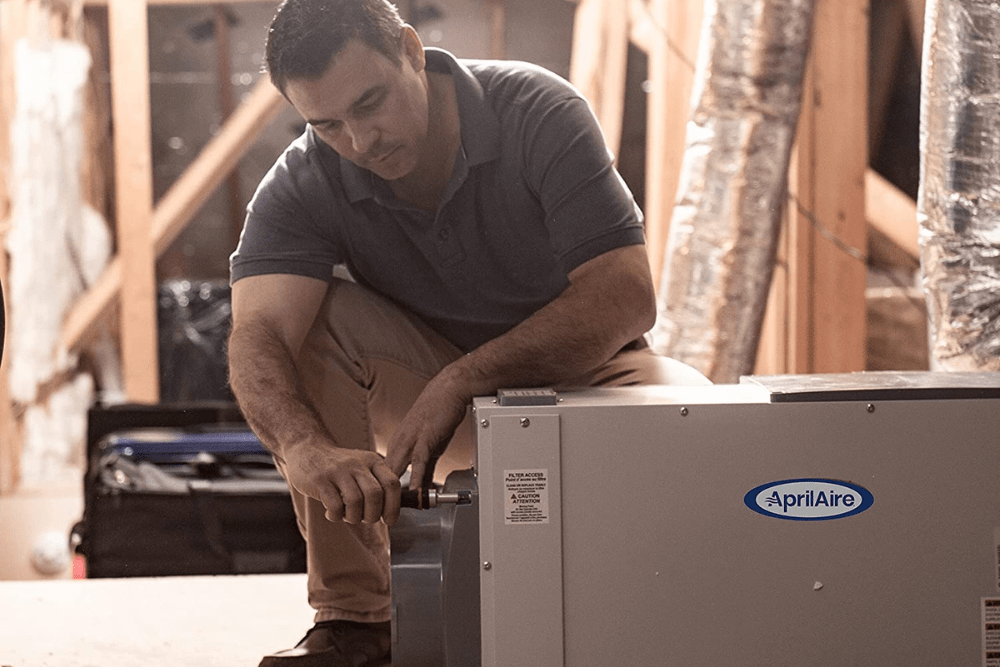
- BEST OVERALL: AprilAire E100C Pro 100-Pint Whole-House Dehumidifier
↓ Jump to Review - RUNNER-UP: Ivation 70-Pint Large-Capacity Dehumidifier With Pump
↓ Jump to Review - BEST BANG FOR THE BUCK: AprilAire E080 Pro 80-Pint Whole-House Dehumidifier
↓ Jump to Review - BEST AIR QUALITY: Santa Fe Ultra98 98-Pint Whole-Home Dehumidifier
↓ Jump to Review - BEST FOR CRAWL SPACES: AprilAire E070 Pro 70-Pint Crawl Space Dehumidifier
↓ Jump to Review - ALSO CONSIDER: Honeywell Ducted 88-Pint Whole-House Dehumidifier
↓ Jump to Review
Our Top Picks
For those looking to reduce the level of humidity in their entire home, odds are that one of the whole-house dehumidifier systems in this lineup will fit the bill. While the following models vary in price and the amount of living space they will effectively treat, each one is designed to reduce moisture in the air so the home’s occupants are more comfortable.
Best Overall
AprilAire E100C Pro 100-Pint Whole-House Dehumidifier
What We Like
- Automatically turns on and off to maintain desired humidity
- Constructed from durable, corrosion-resistant materials
- Condensation is directed via a hose or pipe
What We Don’t Like
- Professional installation is recommended
- A separate condensate pump is required if there’s no available drain
Product Specs
- Dehumidification capacity: 100 pints per day (ppd)
- Coverage: Up to 5,500 square feet
- Weight: 64 pounds
The E100C Pro ducted dehumidifier from AprilAire tops our lineup of whole-house dehumidifiers for quality, efficiency, and convenience. The E100C removes up to 100 pints of water from the air in a 24-hour period and is suitable for use in homes with up to 5,500 square feet of living space. The AprilAire E100 series has been tested and certified by Energy Star as being “most efficient,” meaning it’s among the best models for conserving energy while still providing high levels of indoor comfort and performance.
This dehumidifier installs on a home’s HVAC duct system, and professional installation is recommended. It features a single on/off switch, and the desired relative humidity (RH) level is programmed during installation, so there’s nothing for residents to adjust once installation is complete. Once set, the dehumidifier will sense and maintain the desired RH independently. Alternatively, a wired wall-mount controller (sold separately) can be connected to adjust the dehumidifier from a central location.
This AprilAire dehumidifier comes with caster wheels that are designed to make it easier to roll the unit into place on a hard surface, such as a concrete basement floor. There’s no water tank to monitor or dump—optimally, condensation is routed through a pipe or tube into the same drain the HVAC uses. However, if the unit is located in a spot with no drain, such as a crawl space, a separate condensate pump will be necessary to remove the collected water to a suitable drain.
Get the AprilAire E100C whole-house dehumidifier at Amazon or SupplyHouse.
Runner-up
Ivation 70-Pint Large-Capacity Dehumidifier With Pump
What We Like
- Comes with a 2.25-gallon tank for spaces of 4,500 square feet
- Has an auto shutoff, a frost sensor, and a pump for continuous use
- Easy to install and use right out of the box
What We Don’t Like
- Does not have wheels; may be hard to maneuver
- Operates at a louder volume than other models
Product Specs
- Dehumidification capacity: 2.25 gallons
- Coverage: 4,500 square feet
- Weight: 45.42 pounds
For an easy-to-install and effective option, consider the Ivation 70-pint large-capacity dehumidifier. It has a 2.25-gallon tank and is capable of dehumidifying spaces of up to 4,500 square feet. This whole-house dehumidifier also comes with an auto shutoff, a frost sensor, and a pump for continuous use.
The LCD touch interface also allows the user to switch between modes easily. Plus this small dehumidifier comes with a 16-foot hose for placing the unit where it is needed. This portable dehumidifier does not require a professional for installation.
What our tester says: Glenda Taylor, a Bob Vila staff writer and product tester, notes in the Best Dehumidifier for Basements that “the Ivation dehumidifier provided similar moisture removal results to the other 50-pint models in our test group, but it stood out for its versatility. Thanks to its large 2.25-gallon bucket, it was capable of providing the longest operational time before needing to be emptied—a little more than 8.5 hours. The onboard condensate pump allowed us to pump the water to a sink drain for effortless disposal. We also liked that it came with an auto-restart feature in case of power failure and a defrost feature for use in cool-weather operation.”
Get the Ivation whole-house dehumidifier at Amazon.
Best Bang For The Buck
AprilAire E080 Pro 80-Pint Whole-House Dehumidifier
What We Like
- Desired RH can be set directly on the unit
- Manufactured from rust- and corrosion-resistant materials
- Can be located directly over a floor drain for easy water removal
What We Don’t Like
- Professional installation is recommended
Product Specs
- Dehumidification capacity: 80 ppd
- Coverage: Up to 4,400 square feet
- Weight: 63.0 pounds
There’s no question that ducted dehumidifiers are a costly investment, but those with a smaller living space can spend a little less and still get a high-quality whole-house dehumidifier. Our budget pick is from the same manufacturer as our top pick; it simply has a slightly smaller capacity. The AprilAire E080 is the least expensive model on our lineup, yet it still treats homes up to 4,400 square feet and, like its more powerful cousin, it’s also certified by Energy Star for further savings.
The E080 should be installed by an HVAC professional for best results. It’s designed to be connected to the home’s return-air ducting, removing humidity before the drier air is directed back into the house. The desired relative humidity can be set on the unit during installation, or an alternative controller ( sold separately) can be installed in a more convenient spot.
The dehumidifier can be positioned over a floor drain if one is convenient, or a hose can be run from the unit to a floor drain. If no drain is available, a separate condensate pump will be required to pump the collected water to a suitable drain. The E080 offers a high level of climate control for a fairly affordable price.
Get the AprilAire E080 whole-house dehumidifier at Amazon or SupplyHouse.
Santa Fe Ultra98 98-Pint Whole-Home Dehumidifier
What We Like
- Dehumidifier features a high-efficiency filter
- The unit can be adapted to bring fresh outdoor air into the home
- Well suited for use in midsize homes of up to 2,300 square feet
What We Don’t Like
- Professional installation is strongly recommended
- No built-in controller—a separate controller must be ordered
Product Specs
- Dehumidification capacity: 98 ppd
- Coverage: Up to 2,300 square feet
- Weight: 81 pounds
For midsize homes up to 2,300 square feet, the Santa Fe Ultra98 offers a whole lot of humidity reduction. It can remove as many as 98 pints of water in 24 hours when operating at full capacity, and water drains via a hose into a nearby drain—no tank to dump.
While all dehumidifiers have filters of some sort, the Santa Fe Ultra98 boasts a high-efficiency MERV 13 filter that can trap 90 percent or more of airborne particulates and dust mites that measure up to 3 microns in size. As a comparison, an average human hair is about between 75 and 100 microns thick. Not only does the Ultra98 remove unwanted humidity, it also banishes airborne pollutants.
The Ultra98 installs to the home’s HVAC ducting, and an optional outdoor air intake can be added to introduce fresh air to the home if desired. A separate controller is required for use with the Santa Fe Ultra98—the manufacturer suggests the Ultra-Aire DEH 3000/3000R (sold separately). Other controllers may be compatible, so check with an HVAC technician to be sure. The Ultra98 quiet dehumidifier installs on the home’s HVAC ducting system, and like all whole-house dehumidifiers, professional installation is highly recommended.
What our tester says: Mark Wolfe, a Bob Vila product tester and staff writer, notes in the Best Crawl Space Dehumidifiers that “we liked that this unit treats a large volume of air, operates quietly, and helps the home HVAC perform better. We also liked that it has a secondary adjustable fresh air intake that can infuse filtered, oxygen-rich outdoor air into the home. In our tests, this model did an outstanding job of maintaining the target humidity, and it freshened the air at the same time. The build quality was extremely sturdy, and the unit operated at a very low noise level.”
Get the Santa Fe whole-house dehumidifier at Sylvane or SupplyHouse.
Best For Crawl Spaces
AprilAire E070 Pro 70-Pint Crawl Space Dehumidifier
What We Like
- Removes 70 pints (9 gallons) of moisture per day
- Emits a 200 cubic feet per minute (CFM) airflow for 2,200 square feet
- Automatic operation keeps the humidity level ideal
- Gravity drain system allows for easy emptying
What We Don’t Like
- Does not work with an elevated drain
- Larger and heavier than other options available
Product Specs
- Dehumidification capacity: 70 ppd
- Coverage: 2,200 square feet
- Weight: 56 pounds
The AprilAire Pro 70-pint crawl space dehumidifier offers the best functionality for a crawl space. This model features corrosion-resistant aluminum coils, a 200 CFM airflow, and automatic operation depending on the moisture levels.
This large dehumidifier also comes with a gravity drain system that can be manually emptied once the tank is filled. Though it requires a professional for proper installation, it can run continuously without much maintenance and remove over 70 pints per day.
What our tester says: Mark Wolfe notes in our tested guide that “the large display and simple user interface make the E070 one of the easier models to set up and operate. We had it up and running within 15 minutes. Within 12 hours, the humidity level dropped from 70 percent to 58 percent, and after 24 hours it was 49 percent. In the second 24 hours, readings held in the mid 40 percent range. Several additional features, including a washable air filter, gravity drain, and corrosion-resistant aluminum coils, help to ensure that this unit will deliver years of dependable service.”
Get the AprilAire E070 whole-house dehumidifier at Amazon.
Honeywell Ducted 88-Pint Whole-House Dehumidifier
What We Like
- Offers a high level of dehumidification—up to 88 ppd
- Can be preprogrammed or configured with Honeywell controllers
- Dehumidifies homes with up to 3,500 square feet of living space
What We Don’t Like
- Requires professional installation due to wiring
Product Specs
- Dehumidification capacity: 88 ppd
- Coverage: Up to 3,500 square feet
- Weight: 104 pounds
Those looking for a high-quality, high-capacity ducted whole-house dehumidifier may wish to check out the Honeywell 88-pint whole-house dehumidifier. The second Honeywell model to make our lineup, this model is intended for larger homes with up to 3,500 square feet of living space.
This powerful dehumidifier can remove up to 88 pints of water from the air daily, giving it the highest dehumidification capacity of any pick on our lineup. This powerful Honeywell is well suited to homes in areas with high natural humidity, such as coastal communities and tropical regions.
Professional installation is recommended. The built-in humidistat can be programmed to maintain a consistent humidity level, or the dehumidifier can be controlled with one of several Honeywell thermostats and humidistats (sold separately).
A drain hose can be connected to the unit’s built-in drain port and run to a nearby floor drain. Alternatively, the hose can be connected to a condensate pump (not included) that can pump the collected water to a suitable drain if one is not nearby. While this is a pricey model, it’s made by Honeywell, a name that’s earned a high degree of trust in HVAC and air-treatment appliances.
Get the Honeywell ducted 88-pint whole-house dehumidifier at Amazon or Walmart.
Jump to Our Top Picks
How We Chose the Best Whole-House Dehumidifiers
We researched over 20 dehumidifiers for whole-house use, assessing quality, operating capacity, and cost-effectiveness. While we took brand reputation into account, particularly for industry leaders such as AprilAire and Honeywell, we also explored newer brands that offered competitive pricing and strong buyer reviews. We were looking for models that were quiet, energy efficient, and required minimal maintenance.
For many, the cost of a whole-house dehumidifier is a pricey prospect—homeowners can expect to pay between $900 and $2,000 just for the unit alone. Professional installation can bring the final tally to an average of $1,300 to $2,800. The models in our lineup are well suited for several excess-humidity situations. Still, it’s always a good idea to consult with an HVAC specialist before purchasing one to ensure it’s correctly sized for a specific heating and cooling system.
What to Consider When Choosing a Whole-House Dehumidifier
As a pricey investment, the best whole-house dehumidifiers shouldn’t be an off-the-cuff purchase. Below, learn about the factors and features to keep in mind while shopping for a unit. Whole-house dehumidifier pros and cons run the gamut–some relate to the type of unit while others are associated with the initial investment or operating costs. Still, the benefits of whole-house dehumidifier systems are substantial.
Type
There are two main categories of dehumidifiers: portable and ducted. Whole-house systems fall into the ducted category and connect to a home’s HVAC ducting. When the furnace or central air conditioning is running, moist air from the house is pulled through the return air vents and then through the connected dehumidifier, where the moisture is removed and the dry air is heated or cooled and dispersed throughout the house via vents.
In addition to the different types, there are two main methods of dehumidification: refrigerant and desiccant. In general (although there are exceptions), the desiccant method is used for portable dehumidifiers for rooms, and the refrigeration method is used in whole-house dehumidifiers.
- Refrigerant dehumidifiers work by cycling hot, humid air over a cold surface, usually coils filled with liquid refrigerant. When the hot air passes through the coils, it forms condensation and drips into the collection tank or out of the drainage tube into a floor drain. This is the preferred type of moisture removal found in a whole-house dehumidifier system.
- Desiccant dehumidifiers use chemicals that absorb moisture to pull water from the air as it cycles through the system. The water is collected in a tank or directed to a drain via a hose.
Dehumidification Capacity
Dehumidification capacity indicates how much moisture a dehumidifier can remove from the air daily. It is measured by the number of pints of water removed per day. The capacity can vary—even for the same model—depending on existing humidity, desired humidity level, space size, and temperature. Some manufacturers provide a capacity metric for their dehumidifiers. The Department of Energy provides guidelines and regulates the process of capacity testing for manufacturers seeking certification.
While single-room dehumidifiers usually fall within the range of 25 to 40 pints of moisture removed daily, installed and ducted whole-house systems usually remove between 70 and 120 pints daily. It’s possible to use several room dehumidifiers and achieve the same dehumidification capacity as an installed whole-house dehumidifier. Going this route may make the most sense for renters or those planning to move soon.
Coverage Area
Before purchasing a new whole-house dehumidifier, shoppers will want to take stock of the size of the space they want to dehumidify. Matching the size of the space to the capacity and coverage area of the dehumidifier is known as “sizing.” Accurate sizing is critical to achieving maximum energy efficiency and dehumidification effectiveness.
While capacity and coverage are related, they are not synonymous. Just because a dehumidifier has a high ppd rating doesn’t mean it’s automatically well suited to a larger home. Things such as the size of the unit and the amount of air it circulates factor into the coverage area as well, so check both ratings when comparing dehumidifiers.
Keep in mind that there is no such thing as a portable whole-house dehumidifier because these units are designed to install on the return-air ducting of the home’s HVAC system. They are permanent fixtures.
Airflow
Many manufacturers list their dehumidifier’s airflow rate in CFM, but if it doesn’t appear on the product’s listing, don’t be surprised—it’s not a requirement. Generally, whole-house dehumidifiers come with 100 to 300 CFM ratings, with the larger and more powerful models at the upper end.
This is where the advice of an HVAC professional can come in handy because the goal is to have sufficient airflow to process the air in the home quickly and efficiently. On the other hand, if the airflow exceeds what is needed, the unit can remove excess moisture resulting in dry, itchy skin and higher-than-necessary utility bills from operating an oversize unit.
Keep in mind that units with high airflow ratings may be noisier than those with lower ratings, so the goal is to balance coverage, capacity, and airflow.
Energy Efficiency
The easiest way to ensure getting an energy-efficient unit is by choosing one with Energy Star certification. Another thing to keep in mind is the size of the unit. Something that’s too large for the space in question will cause energy waste, while something too small will cause the system to overwork itself, which lessens its longevity.
Lastly, some dehumidifiers come with smart sensors. Buyers can place the sensors in different areas of the home, and the dehumidifier will run only as needed to maintain the desired humidity level in those areas. In terms of long-term efficiency, modern, fully installed ducted dehumidifiers are more energy efficient than portable room dehumidifiers, but they come with higher upfront costs.
Drainage
Portable units come with internal collection tanks—whole-house dehumidifiers do not. Still, all dehumidifiers remove water from the air, and that water has to have a place to go. Ducted whole-house dehumidifiers are designed with drainage ports, which can be used in two ways. The user can position the drain port directly over a floor drain, which is standard practice, or attach a drain hose and drop the end of the hose in a nearby floor drain.
That works well if the dehumidifier is installed in a basement or utility room next to the HVAC unit because the HVAC unit also produces condensed water that requires a drain. It doesn’t work as well when there’s no space to locate the dehumidifier next to the HVAC unit.
When that happens, the dehumidifier is often located in an adjacent room or below the HVAC unit in a crawl space, and there may be no drain nearby. In those cases, the user will want to install a separate condensate pump and run a drain hose from the dehumidifier to the pump, which then pumps the water to a remote drain or to the yard’s surface, where it can run off.
Additional Features
Helpful extras such as digital displays, remote-control ability, Wi-Fi connectivity, and internal filter-change warning systems make the dehumidifier easier to use. Wi-Fi connectivity or app controllability is a nice feature as it allows users to monitor the unit as it operates and turn the desired humidity level up or down as they choose.
A few whole-house dehumidifiers offer added features, such as a high-efficiency filter that removes airborne particles while removing humidity. Others may offer the option of attaching a fresh-air intake hose that brings outdoor air inside to help reduce stuffiness.
FAQs
Purchasing one of the best whole-house dehumidifiers can be quite an investment, and shoppers might have some additional queries. Check out the most commonly asked questions and their answers below to help you make your decision.
Whole-house dehumidifiers protect a home from damage caused by mold and mildew, which is definitely worth it in the long run. A whole-house dehumidifier is also cheaper and more energy efficient than replacing an HVAC system.
These units draw in humid indoor air, remove excess moisture, and then expel drier air into the home via the home’s vent system.
If a whole-house dehumidifier is designed for continuous operation, it can be run for 24 hours a day. Many models even come with automatic operation, which maintains humidity levels in a home hands-free.
Dehumidifiers for household use should not be used in temperatures lower than 60 degrees Fahrenheit since any cold moisture can freeze the coils and cause malfunctions or irreversible damage.
Like most whole-house appliances, dehumidifiers can be energy intensive. Still, the ultimate cost depends on the ppm rating, the wattage of the unit, and the local cost of electricity. Those trying to get a good idea of the energy usage of a dehumidifier can use an online calculator to help predict the monthly fee. And keep an eye out for a dehumidifier with Energy Star certifications.
Moisture levels and humidity differ based on climate. When deciding what size of dehumidifier is needed, remember that a 30- to 40-pint capacity should cover 500 to 1,500 square feet, while a 40- to 70-pint whole-home dehumidifier can take on spaces of up to 4,500 square feet.
The best spot is close to the existing HVAC system because the dehumidifier must be tied into the ducting. In many homes, this means in a utility room or a basement. If there’s not enough available space right next to the HVAC system, a professional will install the dehumidifier nearby, sometimes in a crawl space, and run the ducting through the walls or floor to reach the HVAC system.
A whole-house dehumidifier install usually costs between $1,300 and $2,800, including the price of the dehumidifier. Extra-large or powerful units can run higher.
Whole-house dehumidifiers with quality constructions can last for 8 to 15 years if used correctly.
